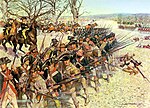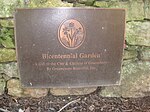Guilford Courthouse National Military Park

Guilford Courthouse National Military Park, at 2332 New Garden Road in Greensboro, Guilford County, North Carolina, commemorates the Battle of Guilford Court House, fought on March 15, 1781. This battle opened the campaign that led to American victory in the Revolutionary War. Though they won the battle, the casualties suffered by the British in this battle contributed to their surrender at Yorktown seven months later. The battlefield is preserved as a National Military Park and operated by the National Park Service (NPS). Based on research of historical evidence, the interpretation of the battle has changed since the late 20th century, which will affect the placement of monuments and markers.
Excerpt from the Wikipedia article Guilford Courthouse National Military Park (License: CC BY-SA 3.0, Authors, Images).Guilford Courthouse National Military Park
Guilford Courthouse National Military Park, Greensboro
Geographical coordinates (GPS) Address Nearby Places Show on map
Geographical coordinates (GPS)
| Latitude | Longitude |
|---|---|
| N 36.131388888889 ° | E -79.846388888889 ° |
Address
Guilford Courthouse National Military Park
27408 Greensboro
North Carolina, United States
Open on Google Maps




